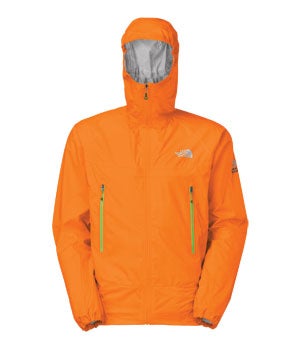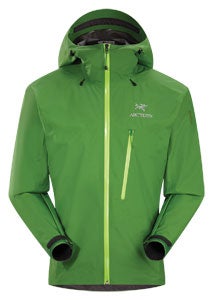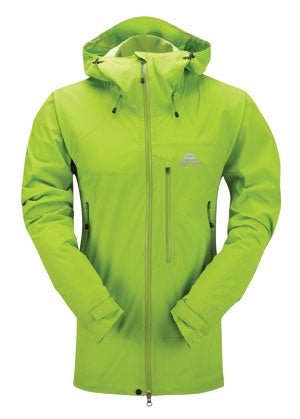Heading out the door? Read this article on the new Outside+ app available now on iOS devices for members! Download the app.
Precipitation is the enemy of the rock climber, and few things are as disappointing as watching your project get drenched in a spring squall. Sport climbers and boulderers need an emergency shell for surprise storms, while ice and alpine climbers rely on these jackets to keep them dry and warm—a dire necessity—in their bad-weather battlefields. No matter your poison, you need a shell that lives in your pack—airy and compressible enough that you don’t notice it sitting there, but resilient enough to keep you dry. Our testers set out to find the best models on the market, and after a soaking-wet six months throughout the Rockies, Northeast, and Northwest, they emerged with five ideal pieces.
Mountain Hardwear Super Light Plasmic
$200; 8 oz.; mountainhardwear.com
Performance

Numerous pitches of chimneys and offwidths on
In Search of Suds
(5.10+) on Washer Woman Tower in Canyonlands, Utah, were no match for the Super Light Plasmic. “This wispy jacket proved itself on the harsh sandstone of Utah,” one tester said of the seemingly thin shell. “It survived abrasion that would shred other jackets.” Not only is proprietary Dry.Q EVAP fully waterproof—it kept users totally dry through drizzles and downpours—but it also stood out in the breathability category: no overheating and sweating out even as temps rose to the mid-50s. Credit this to the spiderweb of channels on the interior of the fabric; these pathways disperse your perspiration across the inside surface of the jacket, and this accelerates evaporation. It is small enough (about the size of a grapefruit) to always have in your pack, which made it great for doubling as a nice windproof layer for 25 mph gales in the Utah desert. Users lauded the fit, too, saying it was “athletic” and “moved well while climbing”; they also praised the supple fabric, which didn’t swish or crinkle like other shells.
Cons
One tester found that the arm holes were too narrow, so she had trouble layering over a fleece or a thick puffy. A long strand of elastic cord hangs down from the waist when cinched.
Conclusion
“I’ve never even heard of another shell that’s totally waterproof, fully breathable, extremely burly, and less than $400.” Get the compressibility, durability, and versatility of a top-notch waterproof jacket at half the price.
Patagonia Alpine Houdini
$199; 6.4 oz.; patagonia.com

Performance
A few years ago, it was unheard of to have a jacket this light be so extreme-weather worthy; one seasoned tester called it “the best ultralight shell I’ve used. Not many others reliably repel water like this one does.” To keep it light but still useful, designers went with a tightly woven water-resistant nylon shell with a DWR surface finish (see “First Defense”
above), and an ultralight waterproof-breathable laminate membrane. The result? An admirable weather-beating shell that weighs less than a No. 3 Camalot. And though it’s translucent, it wasn’t so feathery that it wrapped your torso like tissue paper when it got wet; it stood up solidly to heavy rains and substantial wind. While this piece is bare-bones, there are still plenty of useful features: an adjustable and helmet-compatible hood, cinchable hem, and interior Napoleon pocket that doubles as a stuff sack. “Rack it on your harness, and it takes up less space than a cordelette,” one tester said who dragged it from Colorado to California. “It’s easy to bust this out when the wind is whipping or the rain and graupel start to pelt you.”
Cons
Beware in chimneys and offwidths. It’s so thin that it is susceptible to tears, as one desert-tower tester found. Breathability, while adequate, was limited compared to others in our test.
Conclusion
This jacket fights above its weight class; it’s tough like a heavier shell but still packs small and weighs almost nothing. Use this for summer and milder weather, but bring along a heavier hitter for serious alpine adventures.
The North Face Verto Storm
$199; 7.1 oz.; thenorthface.com

Performance
“This is my new go-to summer jacket for climbing, hiking, biking, and running,” one tester said. “And airflow is the name of the game.” Two high hand pockets open up to huge mesh liners that extend from the belly button to just below the collarbone, and these channel air throughout the front of your torso more effectively than pit zips. One tester wore this for multiple long slogs to Area A in Mt. Evans, Colorado, while another chose it repeatedly for full days in the White Mountains of New Hampshire—both in temps up to 60°F. Our Northeast tester never had to take it off between showers thanks to the extremely thin and breathable 2.5 HyVent fabric. A narrow fit allows only thinner midlayers and slim puffies, but without excess fabric dragging around, climbers felt more secure when chimneying and scumming. “It was nice not to have a Michelin Man effect where the jacket billows out and restricts vision down to my harness,” one user said, who chose this for a questionable-weather day in City of Rocks, Idaho. It also had a sleek fit underneath a gear sling and criss-crossing shoulder slings.
Cons
It was difficult to pack into the dedicated stuff sack/pocket, and there was no easy way to rack it. A few hours of exposure to a downpour left one user feeling chilled from the thin fabric. Hood doesn’t fit a helmet.
Conclusion
With the trimmest fit and highest breathability of any jacket in the test, this shell is ideal for moderate to warm climates when you’re not wearing much underneath and you need maximum ventilation.
Arc’teryx Alpha SL
$275; 10.8 oz.; arcteryx.com

Performance
Three testers in the West gave this shell a 10 out of 10 for waterproofness after dragging it from the 1,500-foot granite dome of Elephant’s Perch, Idaho, to the obscure backcountry crags at Reese Mountain, Wyoming, and experiencing both all-day drizzles and what one called “a crazy-big storm.” She says, “This doesn’t feel like an ultralight shell—it protects like a jacket more than twice its weight. It’s bombproof in stormy weather but also ridiculously light.” Gore-Tex PacLite material throughout the jacket kept testers dry, and it gave this piece a more durable feeling than other thinner jackets in the test. “It’s beyond an emergency shell; I took this in the alpine without a second thought,” one tester said who had it in Rocky Mountain National Park and at Mt. Evans, Colorado. He also called the adjustable-Velcro cuffs, easy-to-operate zippers, helmet-compatible hood, and chest pocket “superb.” One unique feature of the Alpha SL was a six-inch removable foam tube sewn into the bottom hem, which was designed to keep the jacket from pulling up through your harness.
Cons
Moisture built up in this jacket during steep uphill hikes, and this limit in breathability left some testers feeling swampy. Pricier than others reviewed, and some testers would have liked hand pockets.
Conclusion
You get what you pay for—in this case, a full-protection, packable, and versatile shell that has all the features you want for any situation: “For the weight, this is the best rain jacket I have ever used in heavy rain.”
Mountain Equipment Gryphon
$240; 13.6 oz.; mountain-equipment.co.uk

Performance
“Stop-and-go movement when belaying and climbing on the Cable Route of Longs Peak is where this jacket shined,” one tester said. “It repelled all precipitation from the outside and managed moisture perfectly from the inside; the interior was never clammy and felt dry all the time—even right next to skin.” New proprietary Drilite fabric moved sweat vapor through the shell and away from testers’ damp bodies, and large, two-way pit zips maximized airflow in a high-heat area of the body. One tester called the venting system “as good as you can get for any price.” Plus, the inside lining of one hand pocket (opposite side of the chest pocket) and the chest pocket are made of mesh, so they act as vents, allowing in cool air across the entire torso. While a trim, athletic fit was excellent for large reaches and cross-throughs, testers also praised the polyamide outer fabric, saying it felt and stretched more like a softshell. A two-way front zipper made belaying smoother without compromising weather protection. A small piece of wire in the brim allows you to shape the brim however necessary to optimize shielding your face.
Cons
Heaviest in the review, but you do get plenty of extras that other shells don’t have. European zippers (with zipper pull on the left side) took some getting used to, but it wasn’t a dealbreaker.
Conclusion
Sacrifice nothing on this fully featured, lightweight but substantial shell. Fully waterproof, breathable, packable, and durable, the Gryphon is ready for anything you can throw at it—all year long.
FIRST DEFENSE
While a membrane like Gore-Tex does the heavy lifting in keeping you dry, many jackets also have a surface treatment, causing water to bead and roll off the outer fabric. This frontline of water resistance is called durable water repellent (DWR). It consists of a chemical webbing of miniscule spike-like structures that force the water into rounded, bead-like shapes (instead of flat spots or streaks that seep in easier). A DWR treatment weakens when contaminated by commonly found threats: dirt, body oils, perfume, sunscreen, lotion, and bug spray. These contaminants leave behind water-attractive molecules that keep the liquid from beading. It is normal for DWR to break down over time, but you can extend its life. Regularly wash your shell with suitable detergent (mild powder detergent or a specific soap like Nikwax Tech Wash) and give it a spin in the dryer for 10 to 15 minutes, as heat exposure is best at reviving DWR. Then try running a warm iron set on low steam over the jacket a few times. If this doesn’t fix it, find a good spray-on or wash-in DWR; we like Nikwax TX.Direct Spray-On ($21.50, nikwax.com). —Devon Barrow